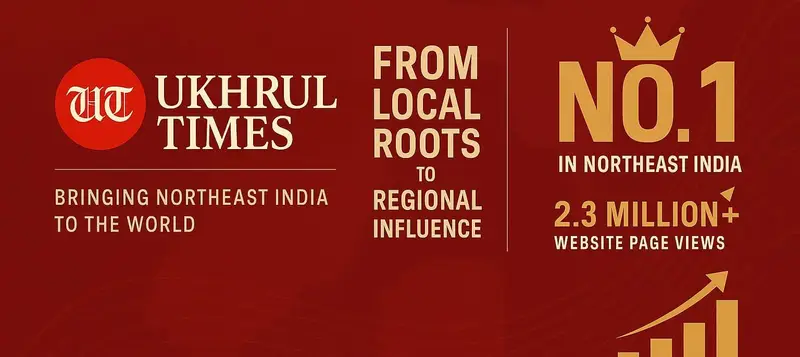Now Reading: Agriculture: the livelihood of 70% of Tangkhul Community
-
01
Agriculture: the livelihood of 70% of Tangkhul Community
Agriculture: the livelihood of 70% of Tangkhul Community

THE HUMAN population continues to increase, posing challenges to food security, global climate, and ecosystems. We will need technological and social innovation to support the growing population as we adapt and mitigate climate change. Our age-old sustainable wet paddy field and terracing have size limitations and lack novelty to sustain our growing and extended family. As per the 2011 census, more than 70% of the Ukhrul population is involved in agriculture and allied activities to feed the family, support the children’s education, and engage in community activities. However, there is no development for farmers and left dilapidated. The challenges of our farmers are not documented in mainstream developmental programs. FAO and other UN groups warned that the loss of soil health and water around our planet is a looming crisis, and more communities are at risk of poverty and social unrest.
Must read | Ukhrul: A town of thousand dried pond

Image 2: General environment information of Phalee village generated using Restor web tool. The approximate size of the crop land is 19 ha i.e. 1.09% of total area of Phalee village indicated in orange bullet (Image courtesy: Rainforest Biodiversity of Phalee).
Our community food security is inherently weak, compounded by remoteness, harsh physical environment, lack of innovation, and lack of transport and communication facilities. The under-study village-Phalee current food grain production capacity is 450 tons annually (30% of its food grains requirement) from 19 ha (Approx) cropland, 1.09% of its total land (Image 1 & 2) (estimated using Restor web tool mapping). How does 70% of the village population (4,000) toil 1.09% of its land to produce 30% of its food grains? It can be predicted from the mapping shown in Image 2 that there will be more forest destruction to meet the cropland demand to feed the ever-growing population. This condition is not an exceptional case of a single village. It exists in all Ukhrul villages except a few. Small cropland, insufficient food production, and a growing population are deeply embedded maladies of rural communities. They are overlooked neither as a problem nor a potential in our society. It is colossal work to increase 70% of our food grains production. On the positive side, it is an opportunity to generate innovation, enhance job creation, and increase income generation.
Must read | FIR against ITLF General Secy baseless, withdraw immediately: Kuki Inpi Tengnoupal
Understandably, there are problems from disproportionate use of agrochemicals, deforestation, forest fires, and degrading environment from waste, water scarcity, and pollution of water bodies, soil, and foods. There is a connection between food security, livelihood, and the environmental element (Image 3). Their disturbance can lead to natural disasters, awful community livelihood, human nutrition deficiency, and stunted mentality. Our community is in a vicious cycle of poverty and environmental degradation driven by unending demand. It led to agriculture malpractice and put pressure on the natural areas around the communities. They resort to cash cropping, poaching, and cutting down trees to sell and buy food, support their children’s education and community engagement.

Image 3: The 17 UN SDG goals is a collection of seventeen interlinked objectives designed to serve as a shared blueprint for peace and prosperity for people and the planet, now and into the future. The SDGs emphasize the interconnected environmental, social and economic aspects of sustainable development by putting sustainability at their center.
Relying on purchasing rather than innovative production and asset creation is an incorrect approach to sustainable livelihood. It’s the right time to bring innovation to our land use system to enhance food production, job creation, and income generation. There are a few realities we have to deal with. Firstly, job opportunities problems despite hundreds of children (10% of the population) of 5-15 years to feed and educate. Secondly, how innovative ideas are lacking despite hundreds of youth (20% of the population)? Thirdly, how 70% of the population toil only 1% of cropland for a whole year and produced only 30% of its food requirement? Are these gaps analogous to our flawed attitude, wrong investment, decadent livelihood approach, and lack of innovation? These gaps indicate inaction, misplacing of talents, lack of social cohesion, and misappropriation of resources and skills. Diversifying livelihood options, encouraging innovations, and setting a common goal can create a positive impact. We must remember that education and food security played pivotal roles in our society since Rev. William Pettigrew in the 1860s.
Must read | Two Kuki-Zo Tribal Brutally Killed; CoTU Calls Emergency Shutdown In Kangpokpi Distt
The food grain production of India has increased from 50 million tonnes in the 1950s to 213 million tonnes in the 2000s, and it reached us through Government ration. It was through the provision of phosphorous, nitrogen, and potassium. The current world supply of ammonia, phosphoric acid, and potash is about 269,482 thousand tonnes. Unfortunately, plants need only a fraction of these nutrients, while a large percentage is precipitated in the soil by metal cations. A high dependence on chemical fertilizers damages the ecological balance, biodiversity, and human health. Chemicals are too expensive for farmers to afford. They are non-degradable and biomagnified through the food web and, finally, the defects that need our resources and time to treat and prolong treatment expenses and hospital stays. There is an increasing number of miscarriages, hormonal problems, neurological defects, leukemia, neuro-toxic, cancer, etc. Agrochemicals degrade the whole biodiversity components like water and soil poisoning and degradation. There is a huge question mark on the safety and sustainability of using chemicals, end users, companies, and regulators. The upcoming ten years is a make-or-break period to take hold of sustainable development.
Must read | Operationalisation of 33 Airtel, Jio, BSNL Mobile Towers in Ukhrul Distt
Revitalizing and promoting local food production and market systems, strengthening social safety nets, enhancing knowledge and awareness about nutrition, and reducing physical and socioeconomic vulnerability can address the existing issues. It needs innovations, resources, investment, and people participation from diverse, cross-sectoral interventions at all levels of the community. The reality of our society is toiling the soil to feed the family, support children’s education, and community services and expenses. We derived wisdom, strength, morals, and culture from agriculture and allied activities. One of our positive strengths is community relationships derived from agricultural activities and manifest in our festivals, rituals, events, religions, and ceremonies. Our cultural values are intertwined with our agriculture. The diminution of agriculture can marginalize 70% of our population to poverty and derail the social fabric that shaped our society. It is essential to make it respectable, dynamic, and progressive. Increasing agricultural productivity through diversification and innovations of multi-cropping or double cropping to meet the food demands and enhance the family income is one positive action.
Also read | Manipur CM N Biren & Director General BRO discuss progress on Indo-Myanmar border fence projects
We need a balanced approach to food production and value additions, market supply chain creation, an uplifting education system, and improving rural infrastructure to achieve sustainable development in the mountainous regions. The strategy must prioritize existing challenges while focusing on local issues. Above all, any development initiative or project can’t be at the expense of humans. Human beings are the most expensive resources, which take years to train and gain the skill. This argument further supports empowering women, students, and youth. Despite the disadvantages, our lands offer unique opportunities in natural resources, such as forests and rangelands, water, flora and fauna, eco-tourism, etc. They have the potential to provide us with additional opportunities. Corrective actions to conserve and enhance productivity, sustainability, and ecological health would significantly improve livelihood and food security. It can strengthen by promoting the local organizations to unearth local solutions and implement area-specific strategies. Transparent and corruption free governance, effective and responsible investment, local farmer friendly approach, and not populism are prerequisites for the resilience of local community food systems.
Related | ITLF clarifies ‘self-rule’ declaration only for Kuki-Zo people; FIR lodged against ITLF General Secy
As a priority, attention can be on food security by revitalizing the neglected-underutilized species (NUS) crops and expanding food production, improving local breeds of livestock, developing non-timber forest products (NTFPs), medicinal and species plants, mountain niche cash crops, and organic agriculture. Strengthening knowledge of nutrition, seed preservation and propagation, harvest, packaging, food processing, and traditional fermented food is vital. Moreover, improving the children’s education system and the vocational and skill development of youth, farmers, and women are crucial resources for long-term community development plans. Lack of skill and specialization and measurable target or unit for development is a real handicap of family farming enterprise system. Community-based decision-making mechanisms and information systems on children’s education, land rights, family health, food and nutrition security, and access and control over essential food-producing resource rights to promote food sovereignty are crucial for Sustainable Development Goals.
Written by: Rinyei Khamrang, Shimreishang NG, Wunglengam AZ , & Ngalengshim
(This work is a part of a study of Rainforest Biodiversity of Phalee (RBP) towards the North East India Bio-cultural Conservation Initiative by the Ministry of Environment, Forest and Climate Change, the National Biodiversity Authority, and the United Nations Development Programme (UNDP-NEICI)). Rainforest Biodiversity of Phalee
Must read | Destruction Of Poppy Cultivation Intensify In Ukhrul And Kamjong Distts

















